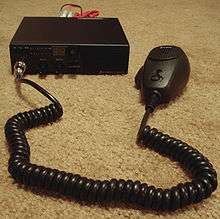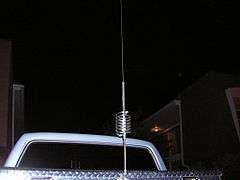Citizens Band radio in India

Citizens' Band radio (also known as CB radio) is a system of short-distance radio communications between individuals on a selection of channels within the 27-MHz (11 m) band. In India, this frequency band extends from 26.957 MHz to 27.283 MHz. There are several different channel plans in use. Citizens' Band is distinct from the Family Radio Service, GMRS, Multi-Use Radio Service and amateur radio (Ham). In many countries CB operation does not require a license, and (unlike amateur radio) it may be used for business or personal communications. Like many other two-way radio services, any Citizens' Band channel is shared by many users. Only one station may transmit in a channel at a time; other stations must listen and wait for the shared channel to be available. Also, the system works in half-duplex mode, which means we may transmit and receive information, but not both at the same time.
Enabling Legislation
[No.R-11014/04/2005-LR] G.S.R. 533 (E).- In exercise of the powers conferred by sections 4 and 7 of the Indian Telegraph Act, 1885 (13 of 1885) and sections 4 and 10 of the Indian Wireless Telegraphy Act, 1933 (17 of 1933), the Central Government hereby makes the following rules, namely:-
- Short title and commencement.
- These rules may be called the Use of low power equipment in the Citizen band 26.957 – 27.283 MHz (Exemption from Licensing Requirement) Rules, 2005.
- They shall come into force on the date of their publication in the Official Gazette.
- Definition.- In these rules, unless the context otherwise requires, -
- "Act" means the Indian Telegraph Act,1885 (13 of 1885);
- "Effective Radiated Power" includes the gain of the antenna, if any;
- words and expressions used in these rules and not defined but defined in the Act and the Indian Wireless Telegraphy Act, 1933 (17 of 1933), shall have the same meanings respectively as are assigned to them in those Acts.
- Use of wireless equipment in the band 26.957 – 27.283 MHz.- Notwithstanding anything contained in any law for the time being in force, no licence shall be required by any person to establish, maintain, work, possess or deal in any wireless equipment intended to be used while in motion or during halts, on non-interference, non-protection and shared (non-exclusive) basis, in the frequency band 26.957 – 27.283 MHz with 5 Watt Effective Radiated Power and built-in antenna
- Interference.-
- Interference is the effect of unwanted energy due to one or a combination of emissions, radiations or induction upon reception in a radio communication system, manifested by any performance degradation, misinterpretation, or loss of information which could be extracted in the absence of such unwanted energy.
- In case where any person to whom a licence has been issued under section 4 of the Act, informs that his licensed system is getting interference from any other radio communication system exempted under these rules, the user of such unlicensed Wireless equipment shall discontinue its use forthwith.
Government of India
Ministry of Communications and Information Technology
(Wireless Planning and Coordination Wing)
New Delhi, the 12th August, 2005
Regulation in India

The channel assignments in India are different from the band plans used elsewhere. The Indian band plan consists of 40 frequencies spaced a relatively tight eight kHz apart, plus a few offset channels used for mountaineering and radio-controlled devices. Many of the channels are reserved for specific purposes such as forestry, disaster relief, and sporting events. The frequency band allocated for this purpose in India is 26.957-27.283 MHz. Nonetheless, the effective radiating power used for Citizens Band is limited within 5 Watt in India.[1]
CB Band Plan
It appears that, as of 2015, several CB manufacturers and distributors are now shipping radios with the India CB band programmed in them. These are generally "multi-norm" radios that provide the user with flexibility in regards to different frequency plans and mode (AM, FM, SSB) regulations. President, Anytone, CRT and other companies are including the "IN" country as an option now. The channel plan programmed in these radios does not match up with the channel plan listed below (odd offset plan starting at 26.964 MHz for channel 1). Instead, the channel plan used is similar to the European standardized 40 channel CB band (AM and FM mode allowed, 4 watts FM, 1 watt AM carrier power for 4 watts peak power – within compliance of the 5 watt limit for India). However, due to the frequency allocation in India being 26.957 – 27.283 MHz, the band plan is 27 channels. Starting with 26.965 MHz for channel 1 and ending at 27.275 MHz for channel 27. This band plan (26.960 – 27.280 MHz) is within the limits prescribed by the Ministry of Communications and Information Technology (Wireless Planning and Coordination Wing). There does not appear to be an official CB channel-to-frequency table as part of the legislation listed as a reference for the "offset" frequency plan. Only the frequency range and power output limits are specified.
It is therefore likely that the "offset" frequency plan originally listed (44 channels in plan total, 11 R/C remote control channels, no mode (AM or FM) specified, no channel number associated, etc. It is possible that the older 44/33 channel list is obsolete, as no radios are produced that offer the offset frequency plan. However, it is probable that both channel plans are currently in use in India, and this will likely continue into the foreseeable future. The 27-channel plan offers wider channel spacing to reduce interference, compatibility with internationally agreed channel plans, and provision for five dedicated and one shared remote control (R/C) for toys, aircraft, boats, telemetry, paging and other non-voice communications. Channels 1–27 are the same as the channels 1–27 for the USA, Australian, and European Union standard channel plans. Not included are the five dedicated R/C frequencies 26.995 MHz, 27.045 MHz, 27.095 MHz, 27.145 MHz, 27.195 MHz and the shared R/C and CB voice frequency of Channel 23 – 27.255 MHz.
| Frequency [MHz] | Usage |
|---|---|
| 26.964 | Hobbyist comms |
| 26.968 [offset] | Mountaineering |
| 26.972 | Hobbyist comms |
| 26.976 [offset] | Mountaineering |
| 26.980 | Highway comms |
| 26.988 | spare |
| 26.996 | spare |
| 27.004 | Radio-controlled model aircraft |
| 27.012 | Rural comms |
| 27.020 | Radio-controlled devices, ex. garage door openers, alarms |
| 27.028 | Rural comms |
| 27.036 | Hobbyist comms |
| 27.044 | Highway emergency (to contact police) |
| 27.052 | Highway emergency (to contact EMS) |
| 27.060 | Marine lifesaving comms |
| 27.068 | Marine lifesaving comms |
| 27.076 | Disaster relief |
| 27.084 | Disaster relief |
| 27.092 | Forestry |
| 27.100 | Forestry |
| 27.108 | Radio-controlled devices, ex. garage door openers, alarms |
| 27.116 | Radio-controlled model aircraft |
| 27.124 | Hobbyist comms |
| 27.132 | spare |
| 27.140 | Mountaineering |
| 27.148 | Radio-controlled model aircraft |
| 27.155 [offset] | Radio-controlled models, general |
| 27.156 | Radio-controlled model aircraft |
| 27.164 | spare |
| 27.172 | Rural comms |
| 27.180 | spare |
| 27.188 | spare |
| 27.196 | spare |
| 27.204 | Mountaineering |
| 27.212 | Rural comms |
| 27.220 | Sports events |
| 27.225 [offset] | Radio-controlled models, general |
| 27.228 | Radio-controlled model aircraft |
| 27.236 | Highway comms |
| 27.244 | Sports events |
| 27.250 [offset] | Radio-controlled toys and gadgets |
| 27.252 | spare |
| 27.260 | Radio-controlled toys and gadgets |
| 27.268 | spare |
| 27.276 | spare |
Updated 27 channel CB radio channel plan (with 5 R/C frequencies annotated):
| Frequency [MHz] | Channel Number |
|---|---|
| 26.965 | Channel 01 |
| 26.975 | Channel 02 |
| 26.985 | Channel 03 |
| 26.995 | Radio-controlled models, general (no voice communications permitted) – "Channel 3A" |
| 27.005 | Channel 04 |
| 27.015 | Channel 05 |
| 27.025 | Channel 06 |
| 27.035 | Channel 07 |
| 27.045 | Radio-controlled models, general (no voice communications permitted) – "Channel 7A" |
| 27.055 | Channel 08 |
| 27.065 | Channel 09 |
| 27.075 | Channel 10 |
| 27.085 | Channel 11 |
| 27.095 | Radio-controlled models, general (no voice communications permitted) – "Channel 11A" |
| 27.105 | Channel 12 |
| 27.115 | Channel 13 |
| 27.125 | Channel 14 |
| 27.135 | Channel 15 |
| 27.145 | Radio-controlled models, general (no voice communications permitted) – "Channel 15A" |
| 27.155 | Channel 16 |
| 27.165 | Channel 17 |
| 27.175 | Channel 18 |
| 27.185 | Channel 19 |
| 27.195 | Radio-controlled models, general (no voice communications permitted) – "Channel 19A" |
| 27.205 | Channel 20 |
| 27.215 | Channel 21 |
| 27.225 | Channel 22 |
| 27.255 | Channel 23 – shared with radio-controlled models. |
| 27.235 | Channel 24 |
| 27.245 | Channel 25 |
| 27.265 | Channel 26 |
| 27.275 | Channel 27 |
Popular use
Citizens Band radio is a good option for long-haul truck drivers to communicate directions, traffic problems and other relevant matters.[3]
Unlicensed Communications
- PMR446 UHF CB system used in most European countries
- Family Radio Service (FRS) UHF CB system used in the USA and Canada
- KDR 444
- LPD433
- UHF CB
- Citizens band radio
- Multi-Use Radio Service (MURS)
- Personal radio service
- General Mobile Radio Service (GMRS)
- Unlicensed Personal Communications Services
See also
References
- ↑ "WPA Notification on Citizens Band". WPA Coordinating Committee. Wireless Planning Commission of India. 12 August 2005. Retrieved 30 August 2012.
- ↑ WPC: Remarks in the National Frequency Allocation Table
- ↑ Alice Adams Trucking:Tractor-Trailer Driver Handbook/Workbook, page 558, the first DB radio